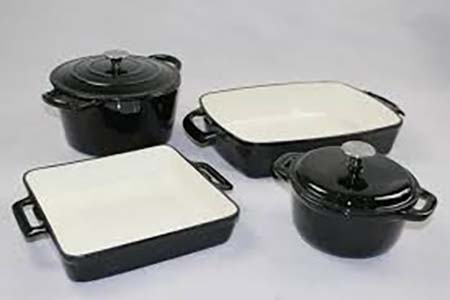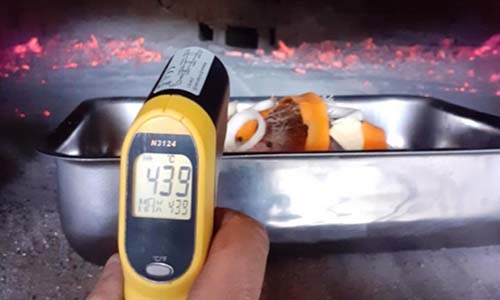This cookware, with its elegant appearance and versatile nature, has found its way into many kitchens. From baking dishes to casserole pans, this type of cookware offers both functionality and aesthetics. But, when it comes to using in the oven, questions arise: Is it oven safe? Can it withstand the high temperatures and thermal shocks of oven cooking? In this guide, we’ll explore its compatibility with the oven.
Understanding Porcelain Cookware

Before we explore the oven safety in more detail, let’s examine the characteristics that contribute the cookware widespread popularity:
- Elegance and Durability: The cookware is renowned for its elegant appearance, often featuring a smooth, glossy finish that adds a touch of sophistication to any kitchen. This is not only visually appealing, but it is also remarkably strong and able to resist scratches and stains. This strength guarantees that your cookware can endure the passage of time, even with frequent use.
- Versatility: This is also is known for its remarkable versatility. It can be used for a wide range of cooking methods, including stovetop and oven cooking. This flexibility allows you to effortlessly switch between different cooking methods when preparing your dishes. Whether you’re sautéing, simmering, or baking.
- Non-Porous Surface: It’s non-porous surface is another notable feature. Unlike some materials that can absorb flavors, odors, or stains, porcelain remains impervious to these culinary influences. This non-reactive nature ensures that your dishes maintain their true flavors and aromas, allowing you to create and savor your culinary creations without any unwanted aftertastes.
Oven Temperatures

Now that we’ve explored the qualities that make the cookware exceptional let’s delve into the critical aspect of its oven safety:
- Typical Safe Oven Temperatures: Most porcelain cookware is designed to be safe for use in the oven at temperatures up to 500°F (260°C) or even higher. This makes it an excellent choice for various oven-based cooking methods, such as roasting, baking casseroles, and preparing other delectable oven-baked dishes.
- Manufacturer Guidelines: While the typical safe oven temperature is a reliable guideline, it’s essential to consult the manufacturer’s specific recommendations. Manufacturers may have slight variations in their products, and following their guidelines ensures that you’re using it in a manner that aligns with their specifications.
Advantages of Using in the Oven
Utilizing porcelain cookware in the oven offers several advantages that enhance your culinary experience:
- Even Heat Distribution: One of porcelain’s notable strengths is its ability to distribute heat evenly. This ensures that your dishes cook uniformly, eliminating the risk of hotspots and uneven cooking. Whether you’re roasting a tender chicken or baking a delicate soufflé, you can be sure that it even heat distribution in a valuable asset.
- Versatility in Cooking Techniques: It can seamlessly transition from baking bread to roasting vegetables or preparing a hearty lasagna. This flexibility enables you to delve into a vast array of cooking methods and test out various recipes, all using just one collection of porcelain cookware.
- Elegant Oven-to-Table Presentation: The aesthetic attractiveness contributes an additional level of refinement to your culinary displays. By using this kitchenware, you can easily transition your dishes from the oven to the table, enhancing the dining experience for both yourself and your guests. The exquisite and ageless style elevates the visual attractiveness of your creations, rendering them equally delightful to the sight as they are to the taste.
Identifying Oven-Safe
Determining the suitability of your cookware for oven use is crucial to ensure safe and pleasurable cooking encounters. To establish the oven safety, follow these guidelines:
- Manufacturer Labels: Many of this cookware items come with labels that specify their safe oven temperature limits. These labels are typically found on the packaging or directly on the cookware itself. Look for phrases like “oven-safe” or specific temperature recommendations, such as “safe for use up to 500°F (260°C).” These labels are your first indication of the cookware’s oven suitability.
- Ask the Manufacturer: If you find yourself uncertain about the oven safety of your particular porcelain cookware, don’t hesitate to contact the manufacturer directly. They can provide you with specific information based on the product’s design and materials. Manufacturers are a valuable resource for ensuring that you use their products correctly and safely.
Dispelling Myths and Misconceptions

In the realm of porcelain cookware, some myths and misconceptions have persisted over time. Let’s clarify a couple of these:
Myth: Porcelain Is Delicate and Fragile
- While indeed boasts a delicate appearance, it is far from fragile. It’s is engineered to withstand the rigors of oven cooking and the demands of daily kitchen use. It’s a durable and robust material designed to serve you well in your culinary endeavors.
Myth: Porcelain Cookware Cracks Easily
- It’s true that porcelain can be vulnerable to thermal shocks, such as moving from a hot oven to a cold surface. However, with proper handling and gradual temperature changes, you can prevent this issue. Being mindful of the temperature transitions and taking a bit of extra care can help you to preserve your integrity.
Caring for Your Porcelain Cookware
Taking good care of your cookware is essential for extending its lifespan and maintaining its pristine appearance:
- Avoid Thermal Shocks: To prevent thermal shocks that can lead to cracking, gradually change the temperature when transferring porcelain cookware from the oven to a cold surface. Place a hot dish on a trivet or towel to provide some insulation.
- Hand Washing: Although there are porcelain cookware items that claim to be dishwasher safe, opting for hand washing is a more delicate approach that can assist in maintaining its shiny appearance and durability. Utilize a mild dish soap and warm water during it cleansing.
- Use Wooden or Silicone Utensils: To prevent scratches and maintain the smooth surface , opt for wooden or silicone utensils when cooking. These materials are gentle to use
- Storage: Store it with care, ensuring it’s not stacked too tightly to avoid chipping. Consider using soft, non-abrasive dividers or cloth liners between stacked items for added protection.
Exploring Alternatives for Oven Use
While porcelain is a versatile and oven-safe material, there are alternative cookware options to consider based on your specific culinary needs and preferences:
- Cast Iron: Cast iron is well-known for its impressive ability to retain heat and distribute it evenly, making it a timeless option for utilizing in the oven. It is ideal for baking, roasting, and preparing hearty dishes that can seamlessly transition from the stovetop to the oven.
- Stainless Steel: Stainless steel, renowned for its long-lasting quality and ability to withstand high temperatures, is perfectly suited for roasting, broiling, and a diverse assortment of oven-based culinary techniques.
- Glass: Glass bakeware is transparent, allowing you to monitor the cooking progress of your dishes. It’s a popular choice for casseroles, lasagnas, and other oven-baked creations.
- Ceramic: Ceramic cookware, much like porcelain, provides consistent heat distribution and a sophisticated display. It is appropriate for a range of dishes cooked in the oven and can effortlessly transition from the oven to the table for a fashionable presentation.